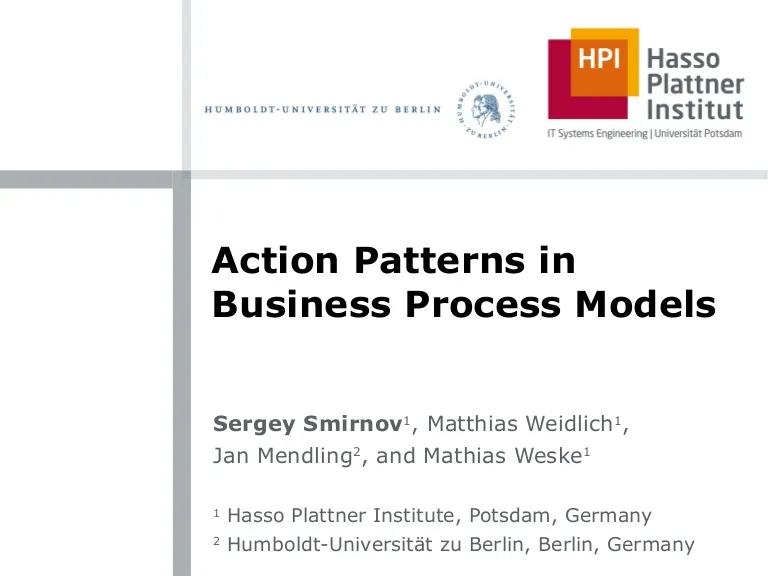Action Patterns in Business Process Models
Description
Business process management experiences a large uptake by
the industry, and process models play an important role in the analysis and
improvement of processes. While an increasing number of sta� becomes
involved in actual modeling practice, it is crucial to assure model quality
and homogeneity along with providing suitable aids for creating models.
In this paper we consider the problem of o�ering recommendations to the
user during the act of modeling. Our key contribution is a concept for
de�ning and identifying action patterns - chunks of actions often appearing
together in business processes. In particular, we specify action patterns
and demonstrate how they can be identi�ed from existing process model
repositories using association rule mining techniques. Action patterns
can then be used to suggest additional actions for a process model. Our
approach is challenged by applying it to the collection of process models
from the SAP Reference Model.
Transcript
Action Patterns in Business Process Models Sergey Smirnov 1 , Matthias Weidlich 1 , Jan Mendling 2 , and Mathias Weske 1 1 Hasso Plattner Institute, Potsdam, Germany 2 Humboldt-Universit ä t zu Berlin, Berlin, Germany Agenda
- Motivation
- Preliminary Concepts
- Co-occurrence action patterns
- Behavioral action patterns
- Evaluation with SAP Reference Model
- Conclusion
- In enterprises the modelers are of different skills and backgrounds.
- An enterprise often maintains a large repository of process models.
- An important problem is to assure the high quality of process models.
- Let us derive information for user support from existing models …
- … and capture it in action patterns – groups of actions which often appear together in business processes.
- Observation
- Labels of model element capture the process business semantics.
- Challenge
- Several labels capture similar meaning
- Solution
- Derive actions from activity labels
- create
- Process model collection is large enough
- Activity label signifies an action
- A mechanism interpreting an activity label as an action exists
- Alphabet of labels
- Process model is a tuple
- A is a finite nonempty set of activities
- G is a finite set of gateways
- F is a flow relation
- s is the only start activity
- e is the only end activity
- Action function derives an action from a label
- Process model collection is a tuple
- is a nonempty finite set of process models
- is the set of all actions in the model collection
- a set of items
- a transaction,
- a collection of transactions
- set of items
- satisfies , if
- Support
- An association rule in a collection is an implication of the form , where and .
- Confidence
- An action is an item
- A process model is a transaction
- A process model collection is a transaction collection
- is a co-occurrence action pattern in process model collection , where:
- is an association rule , where
- minsup is the required minimal support
- minconf is the required minimal confidence
- 1. Strict order (A D)
- Reverse strict order (D A)
- 2. Exclusiveness (F + G)
- 3. Observation concurrency (C || E)
- Behavioral profile is the set of the 3 relations.
- A behavioral relation is an item
- A process model containing a co-occurrence action
- pattern is a transaction
- Process models containing a co-occurrence action
- pattern is a transaction collection
- is a behavioral action pattern in process model collection , where:
- is a rule , where
- and action pairs for which behavioral relations
- are specified
- minsup is the required minimal support
- minconf is the required minimal confidence
- Goals
- I. check if it is possible to derive action patterns from a collection of process models
- II. learn which support and confidence values are encountered in practice
- Means
- Model Collection: SAP Reference Model
- … captures business processes supported by SAP R/3
- … captures 29 functional branches of an enterprise
- … contains 604 Event-driven process chains (EPCs)
- … model element labels are in English
- supp and conf values are small
- … the vocabulary contains synonyms
- some action patterns identify process variants
- the number of derived action patterns is
- reasonable
- Contributions
- Action pattern concept
- Action patterns
- derivation
- Validation with
- SAP Reference Model
- Future work
- Automatic action
- derivation
- Similar actions
- clustering
- Advanced algorithms
- for behavioral profiles
- derivation
- Thank you!
